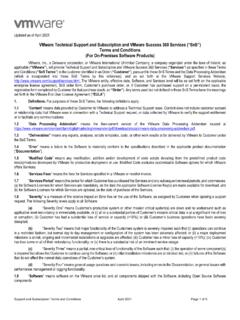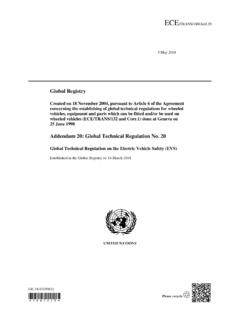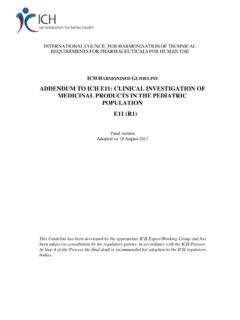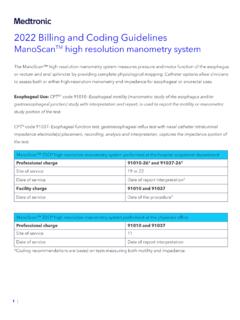Transcription of Health Technical Memorandum 04-01: Safe water in ...
1 Departmentof HealthHealth Technical Memorandum 04-01: Safe water in healthcare premises Part C: Pseudomonas aeruginosa advice for augmented care unitsHealth Technical Memorandum 04-01: Safe water in healthcare premisesPart C: Pseudomonas aeruginosa advice for augmented care unitsHealth Technical Memorandum 04-01: Safe water in healthcare premises: Part C Pseudomonas aeruginosa advice for augmented care unitsiiii Crown copyright 2016 You may re-use this information (not including logos) free of charge in any format or medium under the terms of the Open Government Licence. To view this licence, visit or write to the Information Policy Team, The National Archives, Kew, London TW9 4DU, or email: document is available from our website at summary.
2 IvGlossary and abbreviations .. Introduction .. Hot and cold water services: overview .. Protecting augmented care patients ..4 Appendix A Example of a typical risk assessment to inform the WSP for augmented care units ..7 Appendix B Exemplar P. aeruginosa sample ..11ivExecutive summaryHospital water is a recognised potential source of Pseudomonas aeruginosa (hereafter P. aeruginosa ), which is a microorganism that can act as an opportunistic pathogen and colonise and infect vulnerable patients. Several outbreaks of P. aeruginosa have been attributed to contaminated water systems in addendum to Health Technical Memorandum (HTM) 04-01 published in 2013 advised on how to deal with the presence of P. aeruginosa in augmented care 04-01 Part C (2016) supersedes the 2013 addendum to HTM 04-01.
3 The guidance is directed towards healthcare organisations providing patient care in augmented care settings, specifically aiming to inform estates and facilities departments and infection prevention and control (IPC) teams. As part of the 2016 revision of HTM 04-01, those sections of the addendum that introduced healthcare organisations to the concept of water Safety Groups and water Safety Plans are now a fundamental part of HTM 04-01 Parts A and B. The HSE has also incorporated WSGs and WSPs in its Technical guidance HSG274 Part 2 (see the References section).For the purposes of this document, the patient groups in augmented care settings include:a. t hose patients who are severely immunosuppressed because of disease or treatment: this will include transplant patients and similarly heavily-immunosuppressed patients during high-risk periods in their therapy;b.
4 T hose cared for in units where organ support is necessary, for example critical care (adult paediatric and neonatal), renal, respiratory (may include cystic fibrosis units) and other intensive care situations;c. t hose patients who have extensive breaches in their dermal integrity and require contact with water as part of their continuing care, such as in those units caring for document identifies methodologies to control and minimise the risks of morbidity and mortality due to P. aeruginosa associated with water outlets. It provides guidance on: considerations for water outlets and hot and cold water services in augmented care settings; protecting augmented care patients and ensuring a safe environment; methods of cleaning wash-hand basins and other good hygiene practices to minimise the risk of P.
5 Aeruginosa Technical Memorandum 04-01: Safe water in healthcare premises: Part C Pseudomonas aeruginosa advice for augmented care unitsGlossary and abbreviationsvGlossary and abbreviationsAlert organisms: Alert organisms are microorganisms that have the potential to cause harm and disease in individuals and which can cause an outbreak of infection in a hospital environment. An alert organism is identified by the microbiology laboratory and referred to the infection prevention and control (IPC) team for assessment of possible healthcare-associated acquisition and to identify any possible environmental/equipment care units/settings: There is no fixed definition of augmented care ; individual providers may wish to designate a particular service as one where water quality must be of a higher microbiological standard than that provided by the supplier.
6 While this document provides broad guidance, the water quality required will be dependent on both the type of patient and its intended use. Most care that is designated as augmented will be that where medical/nursing procedures render the patients susceptible to invasive disease from environmental and opportunistic pathogens such as Pseudomonas aeruginosa and other alert organisms. In broad terms, these patient groups will include:a. t hose patients who are severely immunosuppressed because of disease or treatment: this will include transplant patients and similar heavily immunosuppressed patients during high-risk periods in their therapy;b. t hose cared for in units where organ support is necessary, for example critical care (adult paediatric and neonatal), renal, respiratory (may include cystic fibrosis units) or other intensive care situations;c.
7 T hose patients who have extensive breaches in their dermal integrity and require contact with water as part of their continuing care, such as in those units caring for : A biofilm is a complex layer of microorganisms that have attached and grown on a surface. This form of growth provides a niche environment for a wide range of microorganisms to interact and where the secretion of exopolysaccharides by bacteria will form an extracellular matrix for both bacteria and other unicellular organisms such as amoebae and flagellates to remain in a protected : A length of water system pipework leading to a fitting through which water only passes infrequently when there is draw off from the fitting, providing the potential for straightener: A device inserted into the spout outlet of a tap to modify flow, take out turbulence and create an even stream of filter: A filter with a maximal pore size of m applied at the outlet, which removes bacteria from the water outlet.
8 (In this document) refers mainly to taps and showerheads, but other outlets, as indicated by risk assessments, may be considered Safety Group (WSG): A multidisciplinary group formed to undertake the commissioning and development of the water safety plan (WSP). It also advises on the remedial action required when water systems or outlets are found to be contaminated and the risk to susceptible patients is safety plan (WSP): A risk-management approach to the safety of water that establishes good practices in local water distribution and supply. It will identify potential hazards, consider practical aspects, and detail appropriate control supply [to the hospital]: The water supplied can be via: the mains water supply from the local water undertaker ( water company); a borehole; a combination of mains water and borehole supply; emergency water provision (bulk tankered water or bottled drinking water ).
9 List of abbreviationsIPC: infection prevention and controlPOU: point-of-useTMV: thermostatic mixing valveWSG: water Safety GroupWSP: water safety planHealth Technical Memorandum 04-01: Safe water in healthcare premises: Part C Pseudomonas aeruginosa advice for augmented care Part C of HTM 04-01 (2016) focuses on specific additional measures that should be taken to control and minimise the risk of P. aeruginosa. It is aimed at those involved with patient safety and specifically aims to inform and advise healthcare estates and facilities and infection prevention and control (IPC) teams. Although its main focus is control of P. aeruginosa, the document may also have relevance to other waterborne pathogens such as Stenotrophomonas maltophilia, Burkholderia cepacia and atypical Part C should be read in conjunction with HTM 04-01 Parts A and B and HTM 04-01: Supplement Performance specification D 08: thermostatic mixing valves (healthcare premises) as the recommendations given in these documents for the control of Legionella, scalding risks, the testing of thermostatic mixing valves etc are also overview of P.
10 Aeruginosa is given in Chapter 5 of HTM 04-01 Part B. Guidance on: testing for P. aeruginosa is given in Appendix D of HTM 04-01 Part B. sampling for P. aeruginosa is given in Appendix E of HTM 04-01 Part B. the microbiological examination of P. aeruginosa test samples is given in Appendix F of HTM 04-01 Part Additional general requirements for the quality assurance of water systems including those within healthcare facilities should be followed (see the Health & Safety Executive s Approved Code of Practice and guidance on regulations Legionnaires disease: The control of Legionella bacteria in water systems (L8) and the NHS Premises Assurance Model). Hot and cold water services: overviewFor comprehensive guidance on the design and installation of hot and cold water services, see HTM 04-01 Part With the change in focus towards improving the patient environment and minimising the risk of healthcare-associated infections, there has been an increase in the provision of single-bed rooms with en-suite facilities.

















